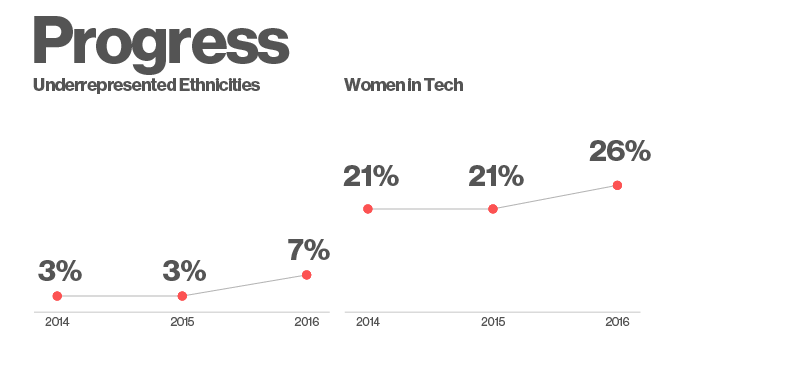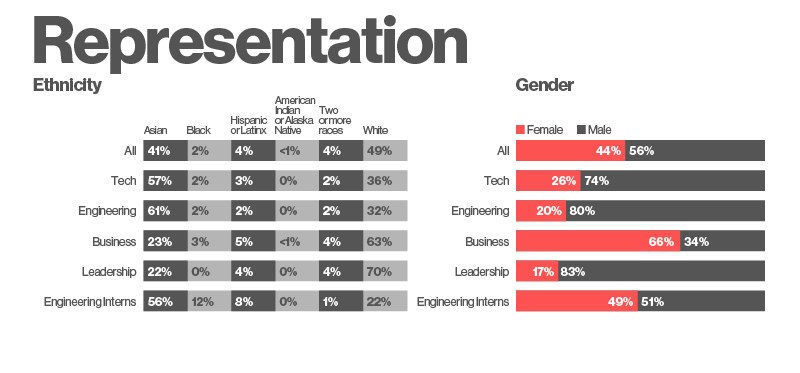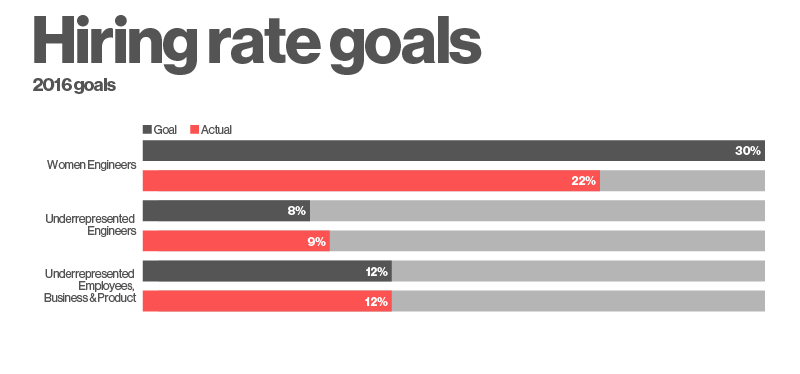A 2016 update on diversity at Pinterest
Evan and I have always believed that building diverse teams is essential to building great products. Diverse teams come with a broader set of experiences, which means they often have new perspectives and ideas. That’s important for Pinterest as we set out to help people around the world discover and do things they love.
Even though we always valued diversity, as we grew quickly, we found that we started to look more and more like a typical technology company—we just didn’t see as many women or underrepresented minorities on our team.
That’s why last year we decided to create goals to increase the diversity of our team and share them publicly. Just having good intentions around diversity hadn't been enough, so we thought setting goals would help us focus across the company. At first, we debated sharing these goals because diversity is such a sensitive topic. But we believed that erring on the side of being open about our progress and what we learned is the best way to help the whole technology industry become more diverse and inclusive.
Our efforts improved our hiring process and resulted in the most diverse team Pinterest has had to date. We didn’t make as much progress as we’d like, but we learned a lot that’s going to help us create an even more diverse Pinterest next year.
In 2016, we increased the number of women in technical roles from 21% to 26% and more than doubled the number of people in the company from underrepresented ethnic backgrounds to 7%. We increased the hiring rate of engineers from underrepresented ethnic groups from 1% to 9%. We were also able to bring on new senior leaders like Li Fan, our head of engineering, Ruben Ortega, head of our Seattle engineering office, August de los Reyes, head of product design and Candice Morgan, head of diversity.
These numbers don’t reflect all the effort that also went into making sure Pinterest as a culture became more inclusive. And it all happened at a time we scaled our company rapidly, growing by 51% this year.
What we learned
Growing more diverse teams takes deliberate, thoughtful work, and it’s not easy. It requires conviction, long-term commitment and a willingness to confront difficult issues. Here are a few things we learned:
1. It’s crucial to continuously talk about why diversity matters. It’s important to talk about why diversity is important as much as how we build a more diverse and inclusive team. We put the processes in place to make the company focus on our new goals, but we would’ve made faster progress if we made sure every hiring manager understood how a diverse company advances our goal of building world class products. We missed an opportunity to delve deeper and get managers to take ownership of the company’s goals alongside recruiters. If we could go back, we’d spend more time explaining the why as much as the how.
2. Hiring senior leadership from diverse backgrounds is important and requires its own effort. A lot of companies focus on bringing in diverse junior talent because they’re easier to hire—but having diverse senior leaders is just as important. When you’re trying to build an inclusive culture, people need to see representation amongst their peers and across senior leadership. Recruiting for executive roles is its own challenge. While we brought on many new leaders from different backgrounds, we could have spent more time on this in the first half of the year.
3. Focusing on diversity improved our entire recruiting process. Our new goals helped us improve internal recruiting practices. We revamped our employee referral process to be more targeted (and therefore more useful) and made our interviewing process more efficient. We rolled out unconscious bias training to all of our interviewers. We experimented with external resourcing firms and while many are great to work with, we got more success when we improved our internal processes.
4. Inclusion and diversity go hand in hand. Creating an inclusive environment where everyone feels engaged and valued is just as important as getting someone in the door. This year we created new internal programs, including employee-led unconscious bias training for all new hires, Inclusion Labs in partnership with Paradigm, and the launch of new employee communities, like Vets@, sponsored by CFO Todd Morgenfeld, and blackboard, our Black employee group.
5. There’s value in pushing the whole industry. Even though the market for hiring is incredibly competitive, we want to go beyond Pinterest and be a small part of pushing the industry forward. We worked closely with organizations like /dev/color and Blavity and partner with other tech companies on creating new solutions. We hosted events that were designed to bring the underrepresented minorities and women in tech communities together without the explicit purpose of recruiting them. We also launched an apprenticeship program to help people transition to tech. We think being open with our efforts and joining the larger community is the right thing to do to help all of us in this industry.
How we did in 2016



Increase hiring rates for full-time women engineers to 30%.
- While we increased the number of women in engineering and technical roles overall, we didn’t reach our goal of a 30% hiring rate for women in engineering. We ended the year at a 22% hiring rate for women engineers starting in 2016. How we’re making sense of this gap: One reason we missed is because we decided to prioritize hiring senior women engineers, and senior hires take longer.
- Additionally, 49% of engineering interns were women, up from 32% last year.
Increase hiring rates for engineers from underrepresented backgrounds to 8%.
- We surpassed this goal. The hiring rate for engineers from underrepresented ethnic backgrounds grew to 9%, up from 1% last year.
- 30% of the underrepresented engineers hired are in senior roles.
- The number of underrepresented ethnic minorities for our 2017 new grad engineering class thus far grew to over 9%, up from <2% in 2015. About 20% of our engineering interns in 2016 came from underrepresented ethnic groups, up from 4% in 2015
Increase hiring rates for people from underrepresented backgrounds to non-engineering roles to 12%.
- We reached this goal, increasing the hiring rate for people from underrepresented ethnic backgrounds in non-engineering roles to 12%, up from 7% last year.
- Underrepresented minorities now make up 7% of our entire workforce, more than doubling from last year.
Implement a Rooney Rule-like requirement where at least one candidate from an underrepresented background and one female candidate is interviewed for every open leadership position.
- Many of our new senior leaders came from underrepresented backgrounds this year, especially in engineering, including Li Fan, head of engineering and Ruben Ortega, head of our Seattle engineering office. In addition, Michelle Wilson became the first independent member of our board.
*Women in tech includes women in engineering, product design and product management
**Underrepresented groups include Black, Hispanic, and Native American
What’s next in 2017
We’re ready to set new goals in 2017.
We updated our women in engineering hiring rate goal to 25% for 2017. We still aspire to 30%—but realize it’s likely going to take more than 12 months to get there. And since we’ve seen so much success with the Rooney Rule for executive roles, we’re extending it to more teams.
Our goals for 2017 are:
- Increase hiring rates for full-time women engineers to 25%
- Maintain hiring rates for engineers from underrepresented ethnic backgrounds at least 8%
- Maintain hiring rates for people from underrepresented ethnic backgrounds in business roles at least 12%
- Extend our Rooney Rule-type requirement to interview at least one person from an underrepresented background and one female candidate for all top-level managerial positions, in addition to exec roles
—Ben Silbermann, CEO